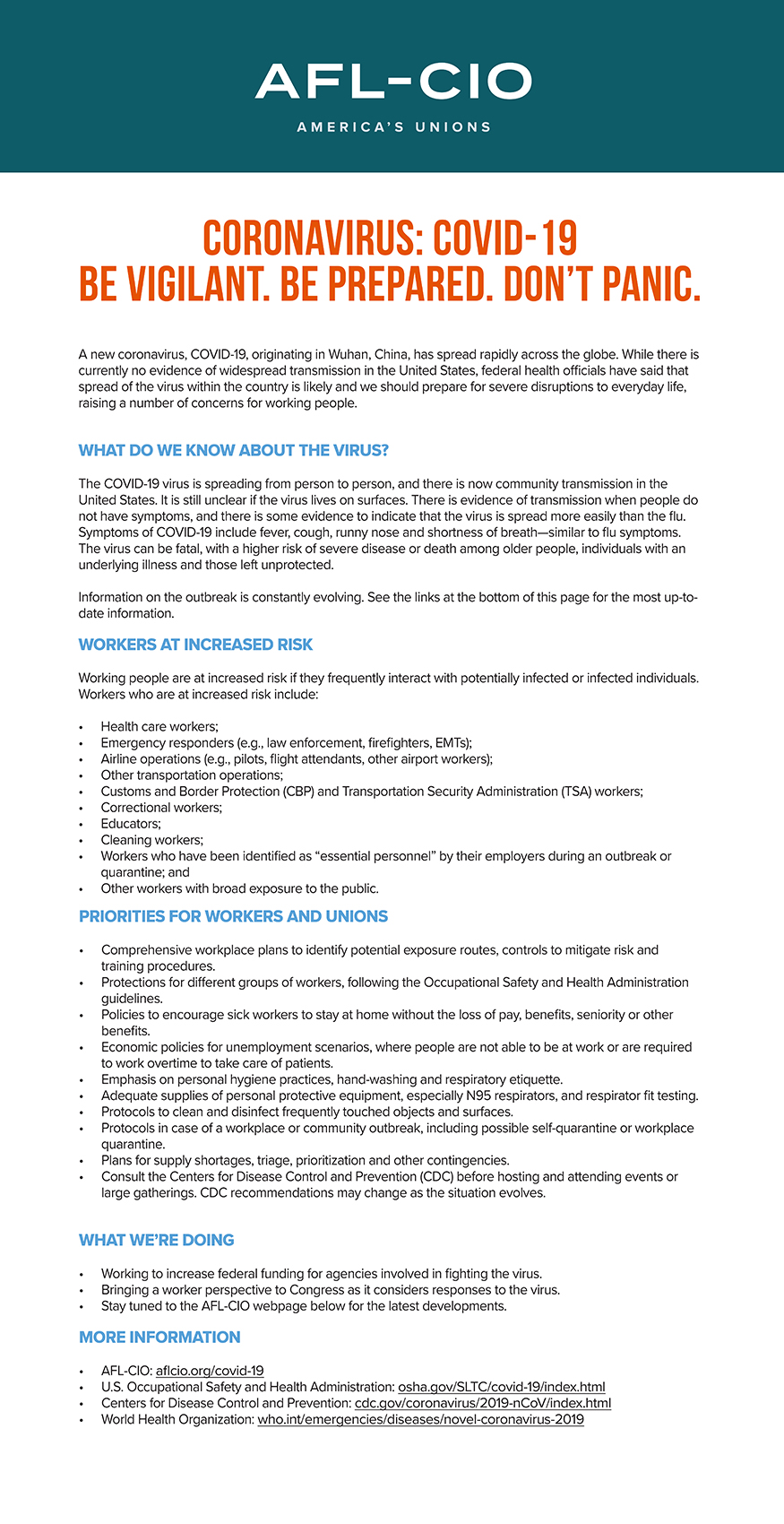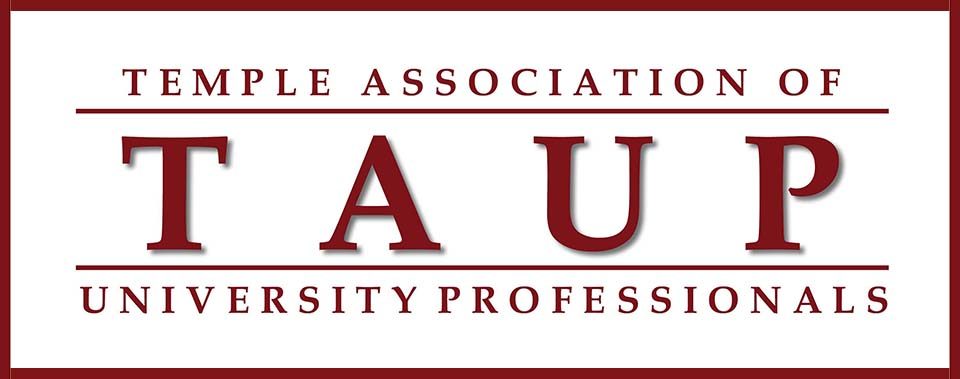Like many in the campus community, as concerns about the spread of the COVID-19 / coronavirus increase, TAUP wants to be sure that our members are aware of any plans the administration has for handling a potential outbreak as well as any information available from public health experts. How prepared are we? How will we and our students and the rest of the Temple community be protected in the case of an outbreak?
The administration has set up this page to keep the Temple community updated. The union has reached out to the administration to clarify the President’s latest email and the text sent on the morning of 3/5. We have been asking questions about sick leave policies and about the plan if the self-quarantining policy is expanded significantly for librarians, academic professionals, and faculty, including the possible move to large-scale teaching online.
Thus far, we’ve been told that our members need to be in communication with their supervisors if they fall under the university’s self-quarantining policy, which may alter as the virus spreads, or if they have other questions.
TAUP is Local 4531 of the American Federation of Teachers, and we’re also affiliated with the AFL-CIO. Read further for useful information from our national unions. Additional information is available on their websites at the links provided below; we hope it helps members to raise any concerns they may have with their supervisors.
Our members have the right to a workplace where adequate infection-control practices keep us safe from exposure to hazards like coronavirus, and our labor laws obligate employers to discuss these matters. As a union, we are interested in engaging in a solution-driven dialogue with the university that will help to ensure we are all protected from coronavirus exposure in the workplace.
If you have a workplace safety concern that you do not believe is being handled appropriately, please reach out to our office taupaft@gmail.com. We urge the administration to provide a clear plan that addresses the safety of our members and the rest of the campus community, and we will keep reaching out to the administration as other concerns and questions emerge.
Here is information from the American Federation of Teachers and a link to informative bulletins on their website:
Excerpts from COVID-19—How to Be Prepared
Bulletin for Higher Ed Faculty and Staff
As of February 24, 2020
(follow link to website for the most up to date information)
We are monitoring the new coronavirus outbreak. The virus is now called SARS-CoV-2 and the illness is called COVID-19. We are committed to providing AFT locals and affiliates with the information needed to protect our members and the communities they serve.
Any effort that we take to prevent the spread of infectious disease is important. The CDC estimates that 31 million Americans have had influenza this season and at least 12,000 people in the United States have died from flu between Oct. 1, 2019, and Feb. 1, 2020.
Symptoms and Transmission
- COVID-19 symptoms include fever and lower respiratory illness—coughing, difficulty breathing and pneumonia.
- It appears that COVID-19 is more prevalent in adults than children. Elderly people and those with predisposing conditions are more vulnerable to the viral illness.
- The SARS-CoV-2 can be transmitted through inhalation of airborne infectious matter, through splashes from coughs onto mucous membranes, and by touching objects contaminated by splashes and then touching the nose, mouth or eyes.
- Thus far, COVID-19 has not been associated with upper respiratory symptoms—runny noses and sneezing.
Public Health Response
- The CDC and the World Health Organization are working to control the spread of the illness and to develop anti- viral treatments and a vaccine through isolation and by tracing the contacts infected people have had.
- Researchers suspect that the SARS-CoV-2 is easily transmitted. It has been confirmed that infected people can transmit before they exhibit symptoms.
- Negative test results do not guarantee that a person is not infected. The CDC warns that patients’ symptoms and histories must be considered in addition to the test results.
Infection Control in Higher Ed Settings
Now is a good time for higher education institutions to review and evaluate their current infection control practices. If employers follow evidence-based guidance from the Centers for Disease Control and Prevention, the risk of exposure to COVID-19 and other droplet/airborne diseases will be significantly reduced.
Universities should evaluate general dilution ventilation in campus buildings to make sure that heating, ventilation and air conditioning (HVAC) systems deliver adequate fresh air to work areas and campus housing. Good indoor air quality can dilute the concentration of infectious viral droplets and aerosols and thus reduce the risks of infection.
Communications to students and staff are critical to keep everyone apprised of the nature of the disease outbreak. Communications help prevent misinformation, profiling and stigmatization.
For more information about preventing the spread of COVID-19, see https://www.cdc.gov/coronavirus/2019-ncov/ about/prevention-treatment.html.
Role of the Union in Protecting Members and Community
Unions have a key role in defending members’ rights to be protected from COVID-19 and other infectious diseases such as seasonal flu. Local leaders can make information requests and demand to bargain on infection control plans and the location and supply of personal protective equipment, like gloves. For more information, see https://www.aft. org/sites/default/files/coronavirus_info_request_local_leaders.pdf.
Recommendations for Site-Specific Facility Planning and Preparation
Colleges and universities should adopt measures to reduce infection spread on campus through a site-specific plan. Those involved in the development of such a plan should include managers with decision-making authority, union representatives, health and safety activists, health services staff, housekeeping and administrative units. The number and job descriptions of people assigned will depend on the size and scope of the facility. The plan should address the following activities, along with any others that may be required by oversight agencies:
- Assessing risk to students and employees.
- Education and training for employees and students.
- Facility readiness: signage, supplies and staffing.
- Housekeeping.
The plan should assess needs, decide how the facility will implement the activities, and identify resources for handling a student who presents with symptoms suspicious for COVID-19. Regular meetings should be held to report the status of preparations and CDC updates.
Assessing the Risk to Students and Employees and Measures to Maintain Their Health
The plan should assess the potential exposure risks for all facility employees and students, including those who live in university housing.
- Consider staff who provide healthcare, sanitation or services that require prolonged close contact.
- Review the sick leave policy and encourage staff and students to stay home while ill. Encourage faculty to adapt their attendance policies for students.
- Provide guidance to students and staff living in university housing on infection control practices and the availability of campus health facilities.
- Consider offering influenza vaccinations on campus.
Wearing Masks
Currently, the CDC does not recommend facemasks for the general public outside of healthcare settings. Wearing masks when ill is common in many countries, and individuals should exercise their own discretion in their use.
Administration, staff and other students should respect those that decide to wear protective masks. Masks are worn for many reasons, and no one should be harassed or targeted because they chose to use them.
Student Health Centers
For student health centers, it is recommended that they follow the standard environmental infection control procedures for healthcare settings found at https://www.cdc.gov/coronavirus/2019-nCoV/hcp/index.html. When students complain of illness, health center staff should ask about recent travel to China. Post signs that promote standard hygiene practices, such as:
- Washing hands often with soap and water for 20 seconds.
- Using an alcohol-based hand sanitizer if soap and water are not on hand.
- Covering the nose and mouth with an elbow or tissue when coughing or sneezing.
- Avoiding touching eyes, nose and mouth.
- Limiting close contact with people who are sick.
CDC-Recommended Strategies Actively encourage sick students and employees to stay home:
- Employees (including subcontracted workers) who have symptoms of acute respiratory illness are recommended to stay home and not come to work until they are free of fever (100.4 degrees Fahrenheit/37.8 degrees Celsius or greater using an oral thermometer), signs of a fever and any other symptoms for at least 24 hours. Employees should notify their supervisor and stay home if they are sick.
- Ensure that university sick leave policies are flexible and consistent with public health guidance and that employees and adjuncts are aware of these policies. They should be encouraged and not penalized for staying home when sick, including providing paid leave.
- Require contractors employing people who work on campus to provide non-punitive, paid sick leave for all of their workers. This includes subcontracted custodial, food service and other operations staff. These workers are vulnerable to pressure to work while sick. The nature of their work places them at higher risk of contracting and spreading infectious diseases.
- Do not require a healthcare provider’s note for employees who are sick with acute respiratory illness to validate their illness or to return to work, as healthcare provider offices and medical facilities may be extremely busy and not able to provide such documentation in a timely way.
- Employers should maintain flexible policies that permit employees to stay home to care for a sick family member. Employers should be aware that more employees may need to stay at home to care for sick children or other sick family members than is usual.
Separate sick employees:
- The CDC recommends that employees who appear to have acute respiratory illness symptoms (e.g., cough or shortness of breath) upon arrival to work or become sick during the day should be separated from other employees and be sent home immediately. Sick employees should cover their noses and mouths with a tissue when coughing or sneezing (or an elbow or shoulder if no tissue is available).
Educate staff and students about best infection control practices:
- Place posters that encourage staying home when sick, cough and sneeze etiquette and hand hygiene at the entrance to your workplace and in other workplace areas where they are likely to be seen.
- Provide tissues and no-touch disposal receptacles for use by employees.
- Instruct employees to clean their hands often with an alcohol-based hand sanitizer that contains at least 60-95 percent alcohol, or wash their hands with soap and water for at least 20 seconds. Soap and water should be used preferentially if hands are visibly dirty.
- Provide soap and water and alcohol-based hand sanitizer. Ensure that adequate supplies are maintained. Place sanitizer in multiple locations.
- Perform routine environmental cleaning:
- Routinely clean all frequently touched surfaces in the workplace, such as workstations, countertops and doorknobs. Use the cleaning agents that are usually used in these areas and follow the directions on the label.
- No additional disinfection beyond routine cleaning is recommended at this time.
Provide disposable wipes so that commonly used surfaces (e.g., doorknobs, keyboards, remote controls and desks) can be wiped down by employees before each use.
Here is a graphic from the AFL-CIO, and a link to their website for even more informative resources:

